
Guests
- Chuck RosinaWMBR-Boston.
- Thérèse HeliczerCampus Green Vote.
Chuck Rosina reports from Cambridge on the Youth Vote ’96 conference, attended by 1,000 students. Youth Vote ’96 is an effort to mobilize at least 50% of youth to vote in the presidential election. A number of students comment on relevant youth issues, including cuts in student aid and the importance of coalition building among youth groups. Thérèse Heliczer, a co-organizer of the conference, discusses the impact of the internet and Motor Voter bills on growing the youth movement.
Transcript
AMY GOODMAN: You’re listening to Democracy Now! I’m Amy Goodman. We’re going to move right into our youth segment, something we’ve been wanting to do for a while now. While some may perceive American college campuses in the ’90s as being apathetic, at best, and conservative, at worst, a national student conference was recently held at Harvard University to kick off a yearlong effort to get young people involved in the political process. Chuck Rosina of WMBR in Cambridge files this report.
CHUCK ROSINA: On the weekend before the New Hampshire primary, over a thousand young people from around the country came to a Youth Vote '96 kickoff campaign at Harvard University's Kennedy School of Government. Youth Vote '96 is a nonpartisan coalition dedicated to increasing youth voter participation in this year's election. Thérèse Heliczer is director of Campus Green Vote and one of the organizers of this conference.
THÉRÈSE HELICZER: We collectively, together, feel that young people have the idealism and vision to lead this country into the next century and that we should be setting the example by voting. I mean, a lot of nations look at Americans and can’t believe that we’re not using our most basic democratic right and voting. And young people will really be setting the standard, I believe, in this next election cycle, that we should be getting out there and voting in record numbers. And Youth Vote ’96 actually has a goal of getting about 50% of young people to the polls. And so, I think that this year will be totally different than other presidential election years and will be a historical one for young people.
CHUCK ROSINA: Thérèse Heliczer cites Motor Voter laws and young people’s use of the internet as reasons for her optimism. Motor Voter made it easier for young Americans to register, and the internet has become a vast organizing tool. 1996 marks the 25th anniversary of the constitutional amendment granting 18-year-olds the right to vote. Few college-age Americans these days are aware that their voting rights are relatively new and resulted from student struggles during the Vietnam War. Kapona Kristi Murphy [phon.], a student and environmental activist from Oregon, explains what motivated her to travel all the way to Cambridge, Massachusetts, to attend this conference.
KAPONA KRISTI MURPHY: I think what this conference is trying to do is amazing. And building power and registering students to vote is something that is critical to the student movement. And what we’re trying to do here is make sure that students have the training to go ahead and be effective in organizing their campuses and organizing in their communities.
CHUCK ROSINA: And what issues are you concerned about mostly?
KAPONA KRISTI MURPHY: Personally, I’m really concerned about the environment and issues of hunger and homelessness. But the conference covers a huge range of issues, ranging from the deficit to environment to how to get media on your campus. So it combines skills and issues and will train students on the things that they need to know about to run very effective voter registration and get-out-the-vote campaigns.
CHUCK ROSINA: Issues and strategies seem to be the driving force of this conference, with partisan politics taking a backseat. Jed Weiss, a sophomore from Harvard University, tells why he thinks this is.
JED WEISS: I think a lot of concern about student aid. There have been bills proposed in the Congress that have proposed dramatic cuts in student aid. And I think that’s an issue that really strikes home with most students here. Even Republican students tend to object to cuts in student aid. Just because you’re Republican doesn’t mean you agree with every bill coming out of the Republican Congress. A lot of Republican friends of mine remain staunch Republicans, but they’re outraged by some of the cuts in student funding that are being proposed.
WORKSHOP LEADER: So, these would be three kinds of coalitions. The youth vote coalition…
CHUCK ROSINA: Some workshops, like this one entitled “Coalitions: The Building Blocks of a Movement,” were aimed at showing students from diverse political affiliations how they can find common ground and work together.
WORKSHOP LEADER: In most cases, the coalitions that you form, a sort of a local youth vote coalition, will be a coordinating coalition. You don’t have to agree on everything, but you’re agreeing that we have — you have a common goal in registering young people to vote and that you’re going to coordinate your resources, so that you’re not duplicating your efforts, so that you’re reaching as broad a group of people as possible. But there’s still flexibility within each organization to take the approach that they think is best.
CHUCK ROSINA: Hi, where are you from?
CLAUDE SNEED: Boston.
CHUCK ROSINA: And what brings you to this conference?
CLAUDE SNEED: I’m a student at Northeastern University, and I’m very political and very active on my campus and my community. And I just feel anything that will get young people more active in their communities, whether it be politically or otherwise, is good. And so that’s why I’m here. I’m here learning how I can bring this stuff back to my university, my community, and make more people get involved.
CHUCK ROSINA: Have you found it worthwhile?
CLAUDE SNEED: Oh, definitely. I mean, this is fun for me. This is like going to a party. I mean, it’s just really exciting. It’s really exciting to see all these young people here that are involved in positive things. Like, at your own university, you won’t see this many people like this doing things like this, so it just really encourages you to go back to school and keep on in the activities. So, it’s been great for me.
CHUCK ROSINA: Claude Sneed of Northeastern University. Youth Vote organizers are hoping to mobilize 12 million people to the polls in November. The determination and desire for positive change expressed by these students made it clear that they are a voting bloc that will have to be reckoned with. It was also obvious that political activism on American college campuses is still alive and well. Again, Thérèse Heliczer of Campus Green Vote.
THÉRÈSE HELICZER: It’s really exciting to see all these young people here. I mean, for me, you know, having done this work for the past several years, it’s always wonderful to share my vision and hear other people’s vision and really get a shot in the arm to continue to do this work.
CHUCK ROSINA: For Pacifica Radio, this is Chuck Rosina reporting from Harvard University.
AMY GOODMAN: And coming up after this break, we’re joined by a number of young people in the studio to talk about their lives. You’re listening to Democracy Now!

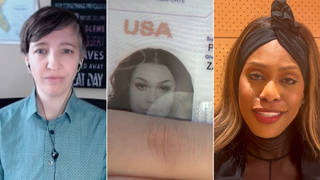
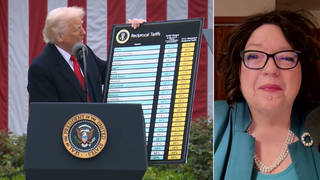
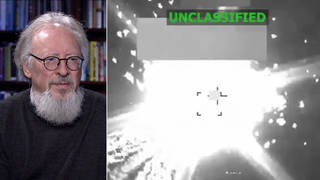
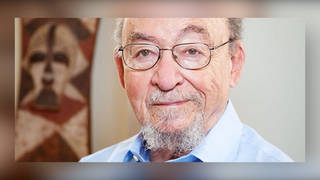





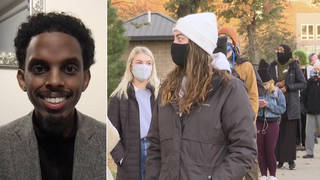
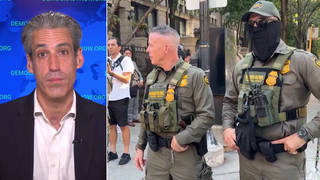
Media Options